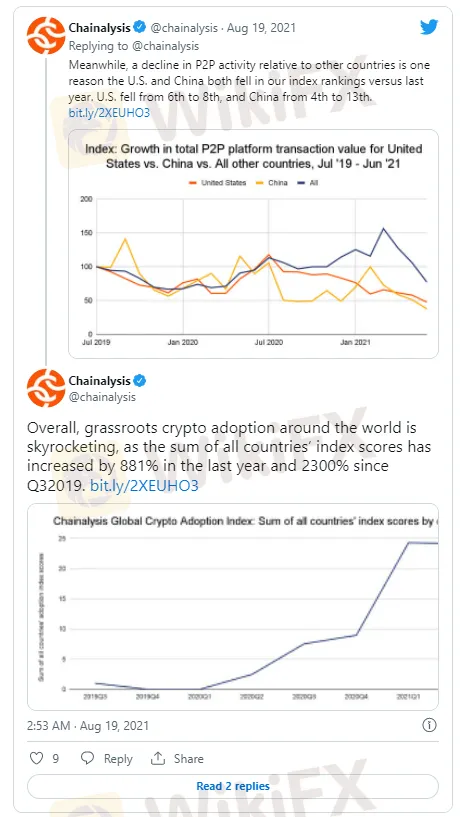简体中文
繁體中文
English
Pусский
日本語
ภาษาไทย
Tiếng Việt
Bahasa Indonesia
Español
हिन्दी
Filippiiniläinen
Français
Deutsch
Português
Türkçe
한국어
العربية
These Are the 3 Biggest Differences Between a Cryptocurrency and a CBDC
Abstract:There are fundamental differences between BTC and central bank-developed tokens – chiefly, the fact that most CBDCs are still in the R&D phase.

Central Bank Digital Currencies (CBDCs) have become a pressing concern for governments all over the world. Every central bank you care to mention, from Jamaica to Japan, is either talking about them, desperately trying to create them or currently trying to launch them.
The subcontinents central Reserve Bank of India could roll out its digital rupee as early as this year.
Meanwhile, in the worlds most populous country, the pace of progress is even faster. China, which is already piloting its digital RMB in 11 major cities – including the capital Beijing, as well as the economic powerhouses Shanghai and Shenzhen – has already begun onboarding its biggest commercial banks and tech firms to the new token.
Even the United States, the worlds biggest economy is mulling a digital greenback launch – with some in the sector calling an American CBDC “inevitable.”
Some say that the advent of crypto has forced central banks hands – pushing them to create their own answer to digital tokens like Bitcoin and Ethereum. But what are the biggest difference between CBDCs and coins like BTC?
CBDCs dont have to use blockchains
Many central banks are building their pilot tokens on existing public blockchain protocols. For instance, South Korea is now testing its digital KRW prototype on the Klaytn blockchain (which uses the native Klay token). The latter was developed by a subsidiary of the domestic internet giant Kakao. Australias central bank is also looking at an Ethereum-powered solution.
The masterminds behind other leading CBDC projects, such as Swedens e-krona initiative, also say they will make use of blockchain and distributed ledger technology.
But unlike crypto – which is by its very nature decentralized – CBDCs don‘t have to use blockchain. Case in point: the digital RMB. China’s leadership has championed blockchain technology but has decided to effectively eschew it in the creation of the e-CNY, currently being showcased to the planet at the Winter Olympics.

In theory, there are a plethora of ways a central bank could create a digital currency, and blockchain technology is just one of a number of tools bankers have at their disposal. The same cannot be said for crypto. Because, as any savvy crypto investor knows, a cryptocurrency without a blockchain is, ultimately, a scam.
CBDCs are the epitome of centralization, cryptos are the polar opposite
The above is a perfect example of the next biggest difference between coins like BTC and CBDCs. The central People‘s Bank of China (PBoC) doesn’t need to use blockchain technology for its token because transparency and decentralization are not its main aims in creating its coin.
Some critics (including Washington-based senators) say that, in fact, the PBoC is creating its e-CNY in a bid to increase centralization.
Governments, Beijing included, hate cash because it is the de facto currency of the black market. They also hate the fact that tech firms currently have a stranglehold on payment platforms because big IT companies operate across borders and can grow extremely powerful.
Skeptics would argue that CBDCs, if successful, would let them kill two birds with one stone. By making a centralized digital currency that has no elements of anonymity built into it, they could (theoretically) do away with black markets, freeze criminals funds, and wrestle back control of payments from IT companies.
Centralization would essentially reposition central banks, currently at the fringes of daily economic activity, as the central, controlling bodies at the heart of domestic finance. Crypto, its advocates claim, seeks to do the exact opposite.

CBDCs are (still) largely theoretical and exist only in the planning stage
Crypto has an enormous head start over CBDCs. Although crypto pay incentives have never really taken off, crypto ownership has shot up in recent years. People may not want to spend BTC and altcoins, but they certainly seem keen to buy them.

You are no longer an outlier if you tell people you own Bitcoin, ETH, or altcoins. In fact, many mainstream financial advisors now tell their clients to keep a small amount of their portfolio in crypto – advice even some city treasuries are taking to heart.
By contrast, CBDCs arent even in their infancy yet. Except for a select few countries such as the Bahamas and Cambodia, CBDC rollouts are still years off, experts have told FXEmpire.
Chinas progress is impressive, but the PBoC is still claiming to be in the “R&D phase” of its digital yuan project. Other nations, such as Israel, are claiming breakthroughs, but the truth of the matter is nobody really knows if, when, and how CBDCs will start launching, or how aggressively central banks will promote them.
In the meantime, crypto keeps on growing. And as central banks now have their hands full battling inflation – another factor that appears to be driving up crypto adoption in multiple regions – crypto advocates agree that CBDCs face an uphill battle in their quest to pass, and surpass, crypto.

Disclaimer:
The views in this article only represent the author's personal views, and do not constitute investment advice on this platform. This platform does not guarantee the accuracy, completeness and timeliness of the information in the article, and will not be liable for any loss caused by the use of or reliance on the information in the article.
Read more

WikiEXPO Global Expert Interviews: Gustavo Antonio Montero: ESG in Finance
As WikiEXPO Dubai concludes successfully, we had the pleasure of interviewing MR. Gustavo, the Chairman and Founder of Carter Capital Management. (Sustainable Digital Assets Management) and Palmer Advisory and Consulting. Palmer is a global business that develops advanced fintech/digital technology solutions and works with Blockchain technologies.

Fidelity Exposed: Traders Complain About Withdrawal Denials, Frozen Accounts & Platform Glitches
Does Fidelity Investments prevent you from accessing funds despite numerous assurances on your requests? Do you witness an account freeze by the US-based forex broker every time you request withdrawal access? Do you struggle with an unstable trading platform here? Is the slow Fidelity customer service making you face forced liquidation? These issues haunt traders, with many of them voicing their frustration on several broker review platforms such as WikiFX. In this Fidelity review article, we have shared quite a few complaints for you to look at. Read on!

Exposing The Trading Pit: Traders Blame the Broker for Unfair Withdrawal Denials & Account Blocks
Did you receive contradictory emails from The Trading Pit, with one approving payout and another rejecting it, citing trading rule violations? Did you purchase multiple trading accounts but receive a payout on only one of them? Did The Trading Pit prop firm refund you for the remaining accounts without clear reasoning? Did you face account bans despite using limited margins and keeping investment risks to a minimum? These are some raging complaints found under The Trading Pit review. We will share some of these complaints in this article. Take a look.

M&G Review: Traders Report Fund Scams, Misleading Market Info & False Return Promises
Applying for multiple withdrawals at M&G Investments but not getting it into your bank account? Do you see the uncredited withdrawal funds out of your forex trading account on the M&G login? Does the customer support service fail to address this trading issue? Does the misleading market information provided on this forex broker’s trading platform make you lose all your invested capital? Were you lured into investing under the promise of guaranteed forex returns? These issues have become highly common for traders at M&G Investments. In this M&G review article, we have echoed investor sentiments through their complaint screenshots. Take a look!
WikiFX Broker
Latest News
2 Malaysians Arrested in $1 Million Gold Scam Impersonating Singapore Officials
Exness Broker Expands in South Africa with Cape Town Hub
Fraud Mastermind Zhimin Qian Sentenced to 11 Years for $6.6 Billion Bitcoin Ponzi Scheme
Is FXPesa Regulated? Real User Reviews & Regulation Check
Almahfaza Broker – 2025 Review: Safe or Scam?
Uniglobe Markets Review 2025: A Complete Guide to an Unregulated Broker
INZO Broker No Deposit Bonus: A 2025 Deep Dive into Its Offers and Risks
Global Guide to Finding Forex IBs/Brokers — Share Your Pick and Win Big!
Trump tariffs are helping drive U.S. beef prices to new highs
Consob Targets Political Deepfake “Clone Sites” and Unlicensed Platforms in Latest Enforcement Round
Currency Calculator



